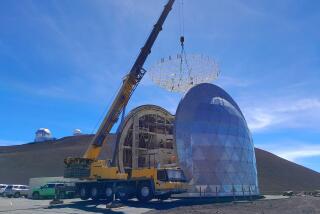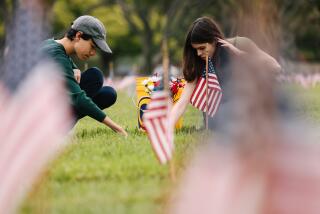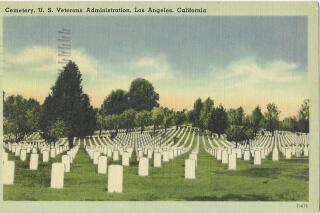Hawaiian Astronaut’s Grave Is a Hero’s Shrine
- Share via
HONOLULU — They come by the hundreds to a special place, high on a hill overlooking the Pacific Ocean, to pay tribute to Challenger astronaut Ellison S. Onizuka.
They come here every day--in buses and cars and sometimes on foot--to the astronaut’s grave at Punchbowl Cemetery, covering it with leis and bouquets of flowers, making a floral design in the shape of an eagle on the chain-link fence behind his tombstone.
“Nothing like this has ever happened here or at any of the other 107 National Cemeteries,” said William Rogers, 54, longtime administrator of Honolulu’s National Memorial Cemetery of the Pacific in the breathtaking beauty of Oahu’s Punchbowl Crater.
Placing leis and flowers on Onizuka’s grave has been a spontaneous daily occurrence since his remains were interred here June 2.
Air Force Lt. Col. Ellison Onizuka’s grave has become a hero’s shrine.
He is a hero not only to every Japanese-American and to all Hawaiians because he was “Hawaii’s astronaut,” but to Americans in general and to the thousands that come here every week from Japan, because he was the first person of Asian descent in space.
“To the people of Japan he is looked upon like a Shogun. They bow before his grave. They kiss the ground. The Japanese revere their dead very highly. For them, Ellison Onizuka was a special human being,” Rogers said.
Seminars in Japan
Onizuka was well-known in Japan. He gave seminars on the space program there. Japanese newspapers and television zeroed in on him during the flight of the Discovery, the 15th shuttle in January 1986, when the Japanese-American was a member of that mission’s crew.
And the Japanese wept and were in shock, along with Americans, when the Challenger blew up seconds after launch last Jan. 18, taking the lives of Onizuka, Ron McNair, Dick Scobee, Michael Smith, Judith Resnik, Greg Jarvis and Christa McAuliffe.
On the Big Island where Onizuka was born and grew up, halfway up the slopes of 13,796-foot Mauna Kea, Hawaii’s highest mountain, the University of Hawaii’s observatory has been renamed the Onizuka International Center of Astronomy.
The airport at Kona is being renamed the Ellison Onizuka Airport. A $500,000 Ellison Onizuka Museum and Educational Center will be built at the airport next year.
Broad-Based Funding
Funds for the construction of the museum are coming from the State of Hawaii, from private donations and from the sale of a hard-cover book containing more than 200 photographs tracing the life of the astronaut.
“Ellison S. Onizuka, a Remembrance” by Dennis M. Ogawa and Glen Grant, authors of several books on Japanese-Americans, sells for $16. The first printing of 10,000 copies sold out within a few days; a second printing of 15,000 is due soon. A $40,000 grant from United Airlines funded the project.
The book ranges in time from the Old Hawaii to which the astronaut’s grandparents Kichihei Onizuka and his wife Wakano came in the 1890s as plantation workers to their grandson’s time.
“A Remembrance” tells the story of the Kona boy from Keopu, a tiny coffee plantation village where his father worked in the coffee fields and drove a taxi and where his mother still runs a general store. Ellison, who was 40 when he died, was one of four children.
Community Values
Hawaii’s Gov. George Ariyoshi, who knew the astronaut as a friend, is quoted in the book: “What impressed me most about Ellison was how he went to NASA a country boy and how he remained a country boy. And I mean country boy in the very finest sense.
“All the values of the community were instilled in Ellison: down-to-earth, a feeling of respect for people, where everyone knows about everyone else and cares about each other. He never lost his country roots.”
The book follows Onizuka’s life through elementary and high schools. He was graduated from Konawaena High School with top honors. He was statewide president of the 4-H club, president of Hawaii’s Young Buddhist Assn., a member of the Big Island’s championship baseball team.
Flight Test Engineer
He was graduated from the University of Colorado and became a NASA flight test engineer in 1978. The book is filled with photographs capturing slices of the astronaut’s life with his wife, Lorna, and their two daughters, Janelle and Darien, plus color photos of astronauts in space and the world as seen from space vehicles.
“The museum at the airport in Kona will feature NASA displays from the early days of America’s space program until now,” explained Onizuka’s brother, Claude, 37, manager of the Kona Community Federal Credit Union and one of 11 members of the Onizuka Memorial Committee organized to establish the museum and educational center.
“Many of Ellison’s personal possessions will be exhibited--his flight suits, helmets, memorabilia relating to his career as a NASA flight test engineer.”
Punchbowl Cemetery was established in 1949. Many of the 2,403 Americans who were killed Dec. 7, 1941, at Pearl Harbor were among the first burials. The 31,912 men and women interred here include soldiers, sailors, Marines, airmen and Coast Guard killed in World War II, Korea and Vietnam.
Because of its spectacular setting in a crater that overlooks Honolulu, the cemetery is Hawaii’s No. 1 visitor attraction. For years, those coming to the islands have come to Punchbowl Cemetery to see the memorials with maps of the Pacific campaigns, to see the courts of honor to the missing in the three wars and to view the grave of war correspondent Ernie Pyle, killed on Ie Shima April 18, 1945.
Ellison Onizuka’s grave is four graves over from Pyle. The astronaut is surrounded by graves of Japanese-American soldiers of World War II who gave their lives in defense of their country, men from the 100th Infantry Battalion, the 442nd Regimental Combat Team, the Military Intelligence Service and the 1,399th Engineers Construction Battalion.
“A remarkable note of interest about this cemetery,” said Rogers, the cemetery’s administrator, “is that 60% of our visitors are from Japan. They come to pay tribute to these men who died in battle, many of whom were killed fighting the Japanese.”
Rogers also noted that more people visit the Punchbowl Cemetery (4.6 million last year) than any other national cemetery, including Arlington in Washington.
Youngsters’ Tribute
“This is a beautiful place,” said John Tuskan, 59, a longtime cemetery worker. “Every year for Memorial Day all of the schoolchildren throughout the state sew together leis for each grave. Then 1,400 Boy Scouts place two leis on each grave, along with an American flag. No other state has a project like it.”
Tuskan said in the 20 years he has worked at the cemetery he has never seen anything like the outpouring of emotion and respect that takes place at the Ellison Onizuka grave.
“It’s something that just happened, from the very first day his remains arrived here. People pour off tourist buses, remove leis from around their necks and place them on the astronaut’s grave. Individuals drive up in cars and hike to the cemetery and place flowers there. It’s unbelievable.”
More to Read
Sign up for Essential California
The most important California stories and recommendations in your inbox every morning.
You may occasionally receive promotional content from the Los Angeles Times.










